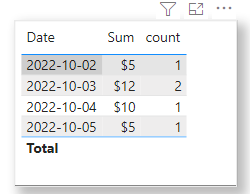Join us at FabCon Vienna from September 15-18, 2025
The ultimate Fabric, Power BI, SQL, and AI community-led learning event. Save €200 with code FABCOMM.
Get registered- Power BI forums
- Get Help with Power BI
- Desktop
- Service
- Report Server
- Power Query
- Mobile Apps
- Developer
- DAX Commands and Tips
- Custom Visuals Development Discussion
- Health and Life Sciences
- Power BI Spanish forums
- Translated Spanish Desktop
- Training and Consulting
- Instructor Led Training
- Dashboard in a Day for Women, by Women
- Galleries
- Data Stories Gallery
- Themes Gallery
- Contests Gallery
- Quick Measures Gallery
- Notebook Gallery
- Translytical Task Flow Gallery
- TMDL Gallery
- R Script Showcase
- Webinars and Video Gallery
- Ideas
- Custom Visuals Ideas (read-only)
- Issues
- Issues
- Events
- Upcoming Events
Compete to become Power BI Data Viz World Champion! First round ends August 18th. Get started.
- Power BI forums
- Forums
- Get Help with Power BI
- DAX Commands and Tips
- Calculate Past Due Backlog Over Time
- Subscribe to RSS Feed
- Mark Topic as New
- Mark Topic as Read
- Float this Topic for Current User
- Bookmark
- Subscribe
- Printer Friendly Page
- Mark as New
- Bookmark
- Subscribe
- Mute
- Subscribe to RSS Feed
- Permalink
- Report Inappropriate Content
Calculate Past Due Backlog Over Time
I have a data set that includes all line items sold, their due dates, actual ship dates, and value. I am able to calculate today's past due backlog (PDBL) by summing the value of all lines whose due date is before today but whose ship date is blank. What I want to do is to create a table that shows what the PDBL was on each day. I don't know how to do this. How can I create a table of dates and compare each line to the date in the table to say 'count me if my due date is before this day but my ship date is on or after this day'. I don't know how to create a table with dates that are not linked specifically to a date for each line item sold, because items can be counted in multiple days if they are late by multiple days. So if something was due 10/2/22 and shipped 10/4/22 I would want its value counted in both 10/3/22 and 10/4/22 of the table.
What date do I use in my output table? Do I have to somehow create a new field? Would I create a measure to reference this new date field and how do I do that?
Here is a quick very simplified example set of data and an example of what I want my output to look like:
Example Data
| Order # | Order Date | Due Date | Ship Date | Value |
| 1 | 09/30/22 | 10/1/22 | 10/3/22 | $5 |
| 2 | 10/1/22 | 10/2/22 | 10/3/22 | $7 |
| 3 | 10/2/22 | 10/3/22 | 10/4/22 | $10 |
| 4 | 10/2/22 | 10/4/22 | 10/4/22 | $5 |
| 5 | 10/3/22 | 10/4/22 | 10/5/22 | $5 |
Output Visual:
| Date | Backlog Value | Backlog Count |
| 10/02/22 | $5 | 1 |
| 10/03/22 | $12 | 2 |
| 10/04/22 | $10 | 1 |
| 10/05/22 | $5 | 1 |
Solved! Go to Solution.
- Mark as New
- Bookmark
- Subscribe
- Mute
- Subscribe to RSS Feed
- Permalink
- Report Inappropriate Content
Hi @aallman
First , you need create a date table to compare with Due date and Ship date . You can extract date from your sample data table . Create a calculated table like this :
Table 2 = CALENDAR(MIN('Table'[Due Date]),MAX('Table'[Ship Date]))
You will get a table like this :
Then create measures to return the sum and count .
Sum = CALCULATE(SUM('Table'[Value]),FILTER(ALL('Table'),'Table'[Due Date]<MIN('Table 2'[Date])&&'Table'[Ship Date]>=MIN('Table 2'[Date])))count = CALCULATE(COUNT('Table'[Value]),FILTER(ALL('Table'),'Table'[Due Date]<MIN('Table 2'[Date])&&'Table'[Ship Date]>=MIN('Table 2'[Date])))
You will get the result you want .
Best Regards,
Community Support Team _ Ailsa Tao
If this post helps, then please consider Accept it as the solution to help the other members find it more quickly.
- Mark as New
- Bookmark
- Subscribe
- Mute
- Subscribe to RSS Feed
- Permalink
- Report Inappropriate Content
Hi @aallman
First , you need create a date table to compare with Due date and Ship date . You can extract date from your sample data table . Create a calculated table like this :
Table 2 = CALENDAR(MIN('Table'[Due Date]),MAX('Table'[Ship Date]))
You will get a table like this :
Then create measures to return the sum and count .
Sum = CALCULATE(SUM('Table'[Value]),FILTER(ALL('Table'),'Table'[Due Date]<MIN('Table 2'[Date])&&'Table'[Ship Date]>=MIN('Table 2'[Date])))count = CALCULATE(COUNT('Table'[Value]),FILTER(ALL('Table'),'Table'[Due Date]<MIN('Table 2'[Date])&&'Table'[Ship Date]>=MIN('Table 2'[Date])))
You will get the result you want .
Best Regards,
Community Support Team _ Ailsa Tao
If this post helps, then please consider Accept it as the solution to help the other members find it more quickly.
Helpful resources
| User | Count |
|---|---|
| 26 | |
| 10 | |
| 8 | |
| 6 | |
| 6 |
| User | Count |
|---|---|
| 31 | |
| 11 | |
| 10 | |
| 10 | |
| 9 |




